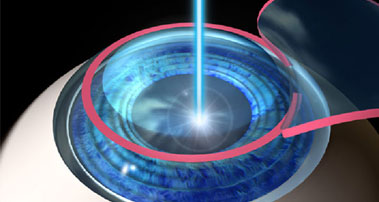
LASIK eye surgery
Description
For clear vision, the eye's cornea and lens must bend (refract) light rays properly, so that images are focused clearly on the retina. Otherwise, the images will be blurry. This blurriness is referred to as a "refractive error." It is caused by a difference between the shape of the cornea (curvature) and the length of the eye.
LASIK uses an excimer laser (an ultraviolet laser) to precisely remove corneal tissue, giving it a new shape so that light rays are focused clearly on the retina. LASIK causes the cornea to be thinner. LASIK is an outpatient surgical procedure. It will take 10 to 15 minutes to perform for each eye.
The only anesthetic used is eye drops that numb the surface of the eye. The procedure is done when you are awake, but you will get medicine to help you relax. LASIK may be done on one or both eyes during the same session.
LASIK involves creating a flap of corneal tissue which is then reflected back so that the excimer laser can reshape the corneal tissue underneath. The amount of tissue the laser will remove is calculated ahead of time. Once the reshaping is done, the surgeon replaces and secures the flap. No stitches are needed. The cornea will naturally hold the flap in place.
Why the Procedure is Performed
LASIK is most often done on people who use glasses or contact lenses because of nearsightedness (myopia). It is occasionally used to correct farsightedness. It may also correct astigmatism. The FDA and American Academy of Ophthalmology have developed guidelines for who would be a good candidate for LASIK.
- You should be at least 18 years old (21 in some cases, depending on the laser used), because vision may continue to change in people younger than 18. A rare exception is a child with one very nearsighted and one normal eye. Using LASIK to correct a very nearsighted eye may prevent amblyopia (lazy eye).
- You should not have this procedure if you are pregnant or breast-feeding, because these conditions can affect eye measurements.
- You should not have this procedure if you take certain prescription drugs, such as Accutane, Cardarone, Imitrex, or oral prednisone.
- Your eyes must be healthy and your prescription stable. If you are nearsighted, you should postpone LASIK until your condition has stabilized. Nearsightedness may continue to increase in some patients until their mid to late 20s.
- You should be in good general health. LASIK may not be recommended for patients with diabetes, rheumatoid arthritis, lupus, glaucoma, herpes infections of the eye, or cataracts. You should discuss this with your surgeon.
Other recommendations:
- Weigh the risks and rewards. If you're happy wearing contacts or glasses, you may not want to have the surgery.
- Make sure you have realistic expectations from the surgery.
For patients with presbyopia, it's important to note that LASIK cannot correct vision so that one eye can see at both distance and near. However, LASIK can be done to allow one eye to see near and the other far, which is called "monovision." If you can adjust to this correction, it may eliminate or reduce your need for reading glasses. In some instances, surgery on only one eye is required. If your doctor thinks you're a candidate, ask about the pros and cons.
Risks
A small percentage of people may need to have another surgery because the condition is over- or under-corrected. Sometimes, you will still need to wear contact lenses or glasses.
Risks may include:
- Corneal infection
- Corneal scarring or permanent problems with the cornea's shape, making it impossible to wear contact lenses
- Decrease in contrast sensitivity -- even with 20/20 vision, objects may appear fuzzy or gray
- Dry eyes
- Glare or haloes
- Light sensitivity
- Night driving problems
- Patches of red or pink in the white of the eye (usually temporary)
- Reduced vision or permanent vision loss
- Scratchiness
Before the Procedure
A complete eye examination will be done before surgery to make sure your eyes are healthy. A signed informed consent form is needed before the procedure. This form confirms that you know the procedure's risks, benefits, alternative options, and possible complications.
After the Procedure
Prognosis
Most people's vision will stabilize in a few days after surgery, but for some people it may take up to 3 - 6 months.
Some people need a second surgery to get the best possible results. Although a second surgery may improve distance vision, it may not relieve other symptoms such as glare, haloes, or problems with night driving. Often, these problems will go away by 6 months after the surgery, but a small number of people may continue to have problems with glare. If your distance vision has been corrected with LASIK, it is likely that you will still need reading glasses at around age 45.
LASIK has commonly been performed in the United States for more than 15 years. Most people seem to have stable and lasting vision improvement.
References
Wilkinson PS, Davis EA, Hardten DR. LASIK. In: Yanoff M, Duker JS, eds. Ophthalmology. 3rd ed. St. Louis, Mo: Mosby Elsevier; 2008:chap 3.5.
Yanoff M, Cameron D. Diseases of the visual system. In: Goldman L, Schafer AI, eds. Cecil Medicine. 24th ed. Philadelphia, Pa: Saunders Elsevier; 2011:chap 431.
Update Date: 6/2/2012
Updated by: Linda J. Vorvick, MD, Medical Director and Director of Didactic Curriculum, MEDEX Northwest Division of Physician Assistant Studies, Department of Family Medicine, UW Medicine, School of Medicine, University of Washington. Franklin W. Lusby, MD, Ophthalmologist, Lusby Vision Institute, La Jolla, California. Also reviewed by David Zieve, MD, MHA, Medical Director, A.D.A.M. Health Solutions, Ebix, Inc.
